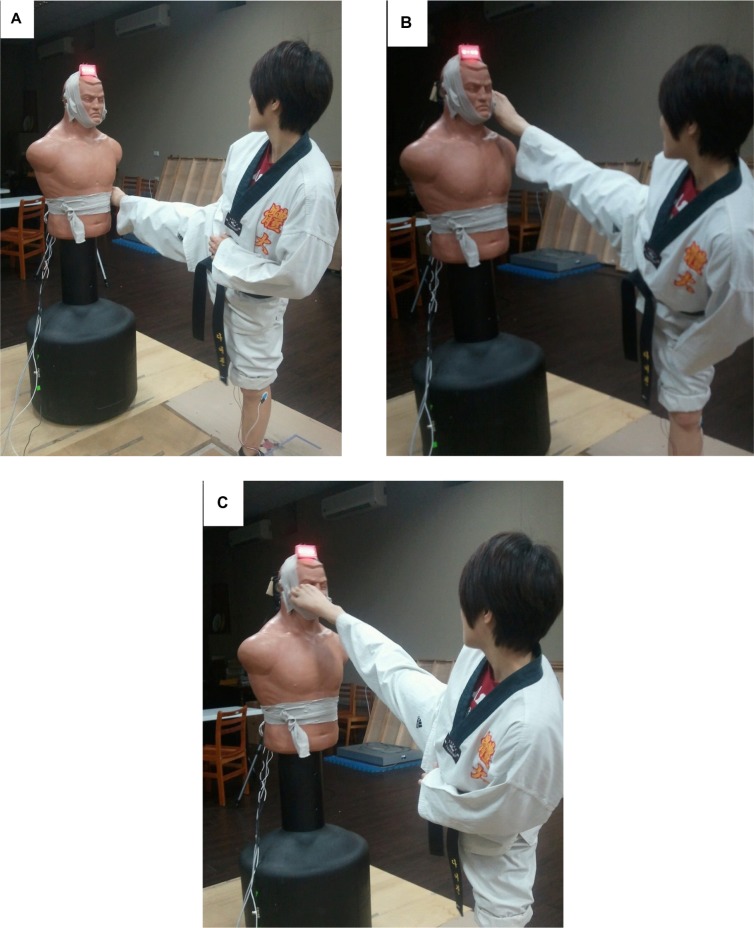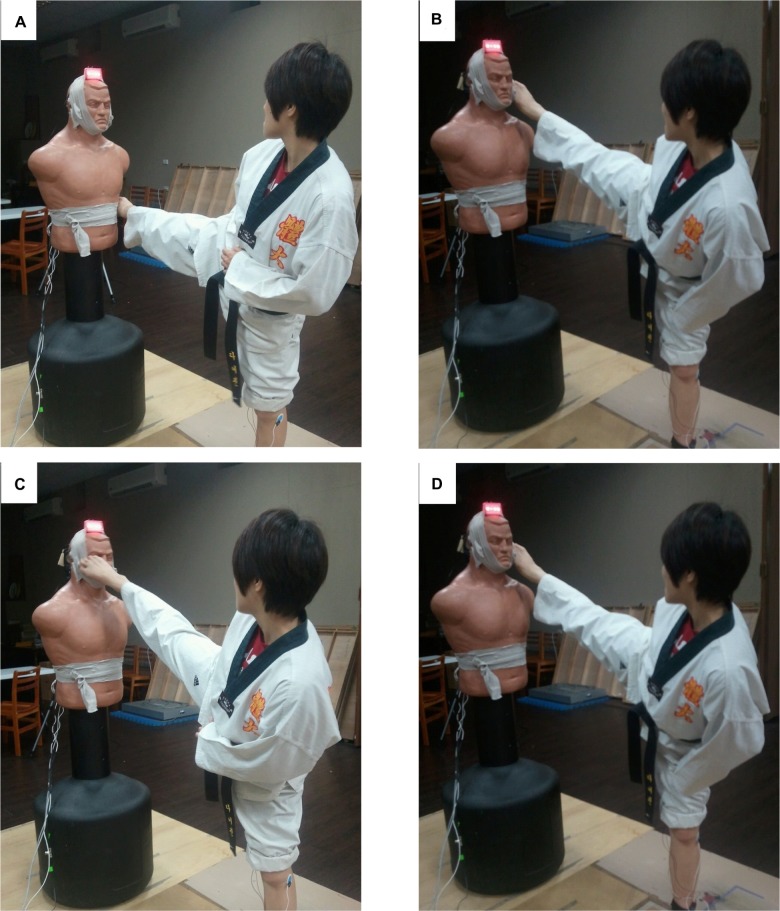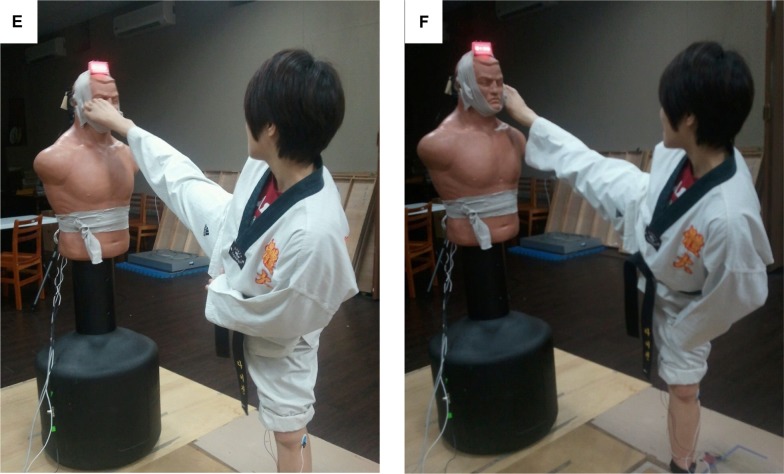Abstract
The dual-task methodology, conducting two tasks simultaneously, may provide better validity than the traditional single-task tests in the environment that is closely related to real sport competitions. The purpose of this study is to determine the reliability and validity of a dual-task test that aims to measure the reaction time and skill proficiency in roundhouse kicks in elite and sub-elite taekwondo athletes. The dual-task results were compared to those in the single-task movements with various levels of complexity. The single-task movements A, B, and C were composed of one, three, and five roundhouse kicks, respectively. The dual-task movement D was composed of movement C and a push of a button in response to a light stimulus as the secondary task. The subjects were 12 elite and 12 sub-elite male taekwondo athletes. The test included four movements with five repeats of each movement in a randomized order. Each subject conducted the same test on two consecutive days. The intraclass correlation coefficient (ICC) showed moderate-to-high correlation in the premotor time (ICC =0.439–0.634 in elite and ICC =0.681–0.824 in sub-elite), motor time (ICC =0.861–0.956 in elite and ICC =0.721–0.931 in sub-elite), and reaction time (ICC =0.692 in elite and ICC =0.676 in sub-elite) in the secondary task in both groups. The elite athletes had significantly faster premotor time than their sub-elite counterparts in all the four movements (all P<0.05). The largest difference lies in the reaction time in the secondary task, in which the elite group (0.248±0.026 seconds) was 33.0% faster than the sub-elite group (0.370±0.081 seconds) (P<0.001). This study shows that the test developed in this study has reasonable reliability and validity in both single- and dual-task methods. In addition, the dual-task method may be a more appropriate way to assess the reaction time and skill proficiency in taekwondo athletes.
Keywords: roundhouse kick, premotor time, motor time, reaction time, elite athlete
Introduction
Taekwondo became an official Olympic sport in 2000. The recent rule change that awards kicking to the head 3 points, compared to 1 point to the chest, has made kicking the primary attack skill in taekwondo. Roundhouse kick is usually the skill that can be conducted with the fastest speed1 and has the greatest efficacy2 in most taekwondo athletes.
Reaction time is a crucial factor in success in taekwondo and other combat sports for quick response to opponent’s movements.3 Total reaction time, the time between the stimulus and the initiation of action, can be divided into two parts according to electromyography (EMG) results. The period of time between the onset of the stimulus and the beginning of the EMG signal is called the premotor time. The second component is called the motor time, defined as the period from the increase in EMG signal to the actual beginning of the observed muscle movement.4 Although the reaction time is routinely measured when establishing the physiological profile of athletes, the difference between the elite and sub-elite athletes may be small. This is especially true when the required movement is the main action of the respective sport that has been practiced numerous times. Indeed, it has been shown that the difference in the total reaction time in roundhouse kick between experts and novice taekwondo athletes was insignificant, with an average difference of ~0.05 seconds.3 In addition, the total reaction time in female athletes of Germany national taekwondo squad was not significantly different from their regional counterparts of the same age.5 It is very likely that even the sub-elite athletes have spent significant amount of time in practicing the main task in their respective sport. The movements have become automatic, making it difficult to distinguish the reaction time between the elite and sub-elite athletes.
Owing to the limitation of single-task reaction time in distinguishing the elite and sub-elite athletes, the dual-task methodology may be adopted to measure the attention needed for the primary task in athletes. It has been suggested that the central processing capacity of attention is fixed. When performing the two tasks simultaneously, the majority of the processing capacity is distributed to the primary task. If the primary task is relatively easy or proficient, more attention capacity can be allocated to the secondary task, resulting in better performance in the latter.6 Therefore, the performance in the secondary task can be considered as an indirect reflection of the proficiency of the primary task.7,8 In addition, dual tasking is necessary in many sport competitions. For example, taekwondo athletes have to be able to read and predict the opponents’ next move while performing an attack or defensive task. The better performance in the secondary task may indicate a greater attention capacity that can be allocated to assess the opponent’s movements. Despite its benefit, the application of dual-task methodology in skill evaluation of elite athletes is still scarce. The purpose of this study is to determine the reliability and validity of a dual-task test that aims to measure the reaction time and skill proficiency in roundhouse kicks in elite and sub-elite taekwondo athletes. In addition, the dual-task results were compared to the single-task movements with various levels of complexity.
Materials and methods
Subjects
Twelve elite and 12 sub-elite male taekwondo black-belt athletes were recruited for the study. The subjects in both groups have been receiving training for taekwondo competitions for at least 6 years. The elite athletes have won medals in international and/or national competitions during high school or university. The sub-elite athletes have never won any medal in international or national competitions during the same period. The basic characteristics of the subjects are shown in Table 1. The elite group was significantly taller than the non-elite group. The study protocol was approved by the Research Ethics Committee, China Medical University and Hospital, Taichung, Taiwan. All the subjects gave their written informed consent after the experimental procedure, and potential risks were explained.
Table 1.
Basic characteristics of subjects in the elite and sub-elite groups (mean±SD)
| Elite (n=12) | Sub-elite (n=12) | |
|---|---|---|
| Age (years) | 20.1±0.8 | 20.4±0.7 |
| Height (m) | 1.77±0.04 | 1.71±0.06* |
| Body weight (kg) | 66.9±5.0 | 65.3±8.8 |
| Body mass index (kg/m2) | 21.3±0.9 | 22.2±2.3 |
| VO2peak (mL/kg/min) | 44.9±6.8 | 41.8±7.0 |
| Experience (years) | 9.9±2.2 | 9.9±2.3 |
Note:
Significantly different between the elite and sub-elite groups (P<0.05).
Abbreviations: SD, standard deviation; VO2peak, peak oxygen consumption rate.
Single task
A dummy was set up as the attack target. A signal light was attached on the head of the dummy (Figure 1A), and a three-axial accelerometer (EGAXT3; Measurement Specialties, Hampton, VA, USA) was installed at the back (Figure 1B). EMG electrodes were attached to the left thenar and brachioradialis muscles (Figure 2A). The subjects stood firmly on flat ground with each foot on a force platform (9260AA6; Kistler, Winterthur, Switzerland), while holding a button in the left hand (Figure 2B). The signals from accelerometer, EMG, force platforms, and the button were collected through a data acquisition and analysis system (MP150; BIOPAC Systems, Inc., Goleta, CA, USA).
Figure 1.
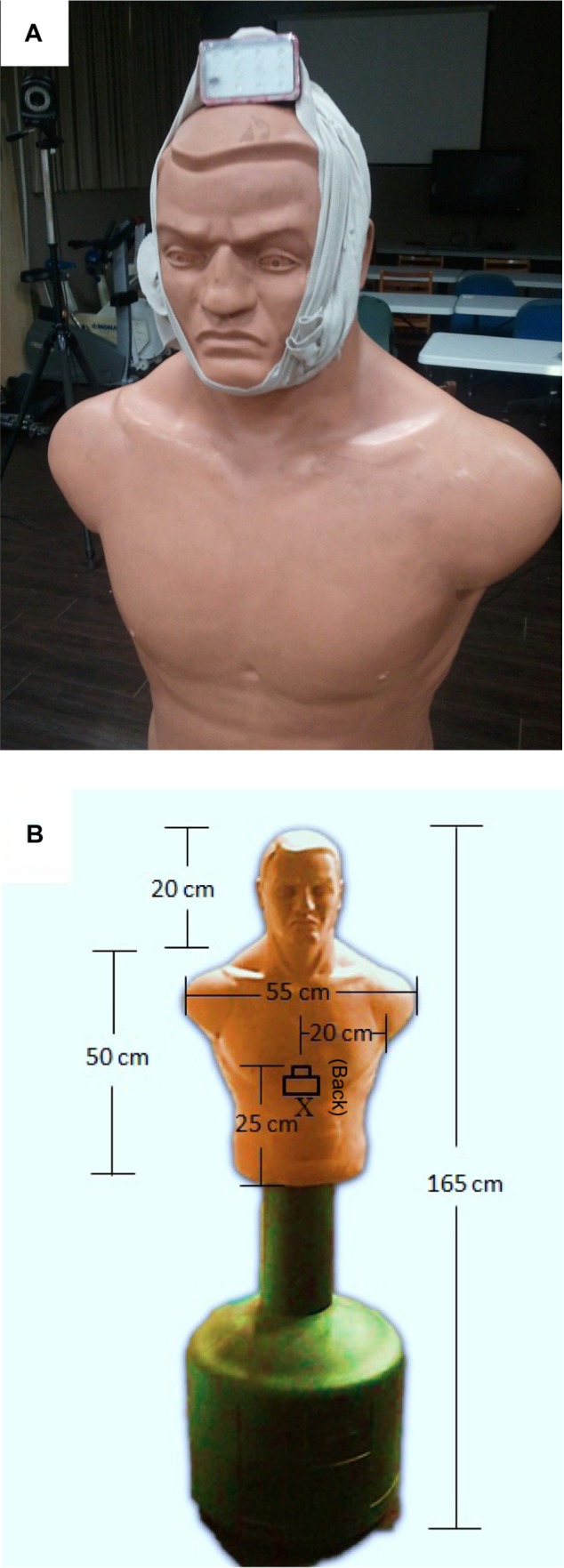
The position of the light (A) and accelerometer (B) in the dummy.
Abbreviation: X, accelerometer.
Figure 2.
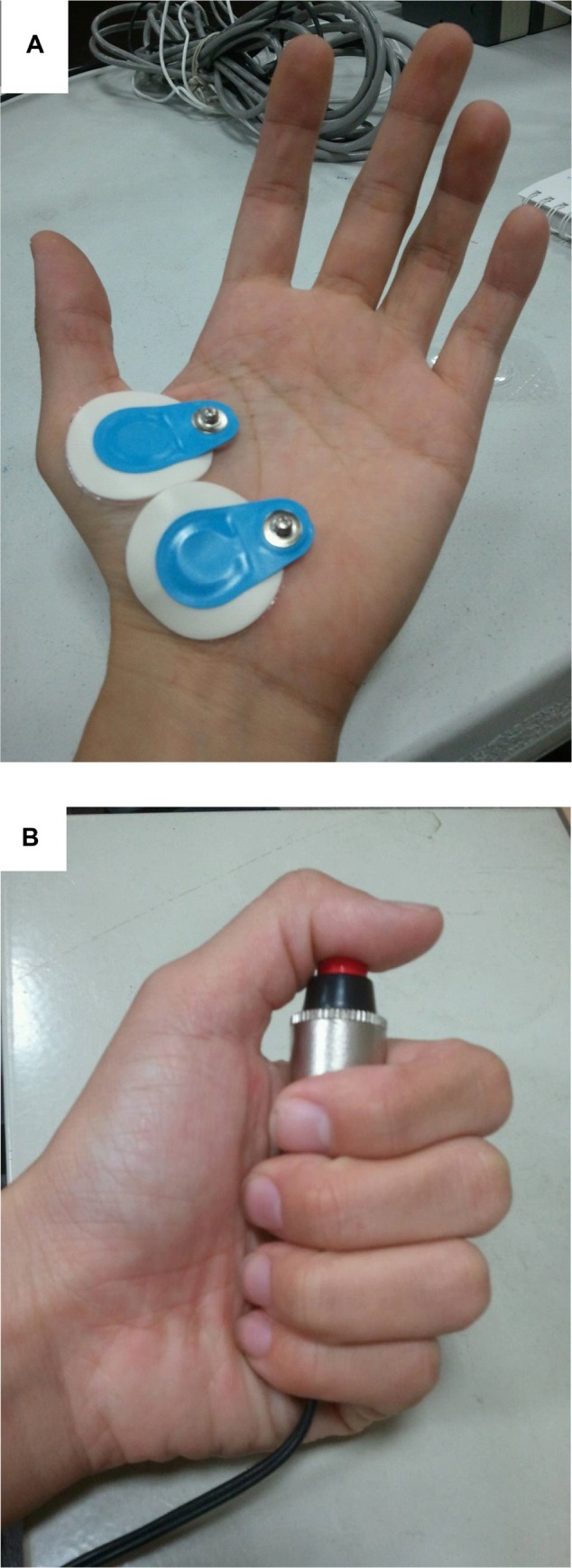
The position of EMG electrodes in the left hand (A) and the handheld button (B).
Abbreviation: EMG, electromyography.
The subjects stood in a guard position with both heels on the ground and waited for the light signal. The subjects were asked to press the button on the left hand with the thumb as soon as they see the light signal, and then start the respective movement to attack the dummy. Three sets of movement were used: A) a roundhouse kick to the rib (Figure 3); B) a roundhouse kick to the rib, a roundhouse kick to the head, and then a reverse roundhouse kick to the head (Figure 4); and C) a roundhouse kick to the rib, a roundhouse kick to the head, a reverse roundhouse kick to the head, a roundhouse kick to the head, a reverse roundhouse kick to the head, and then a roundhouse kick to the head (Figure 5). All the subjects used the right leg as the dominant side in roundhouse kicks. Therefore, all the movements were carried out using the right leg in all the subjects. The subjects could only put the right foot back to the ground after all the kicks were performed in the movement.
Figure 3.
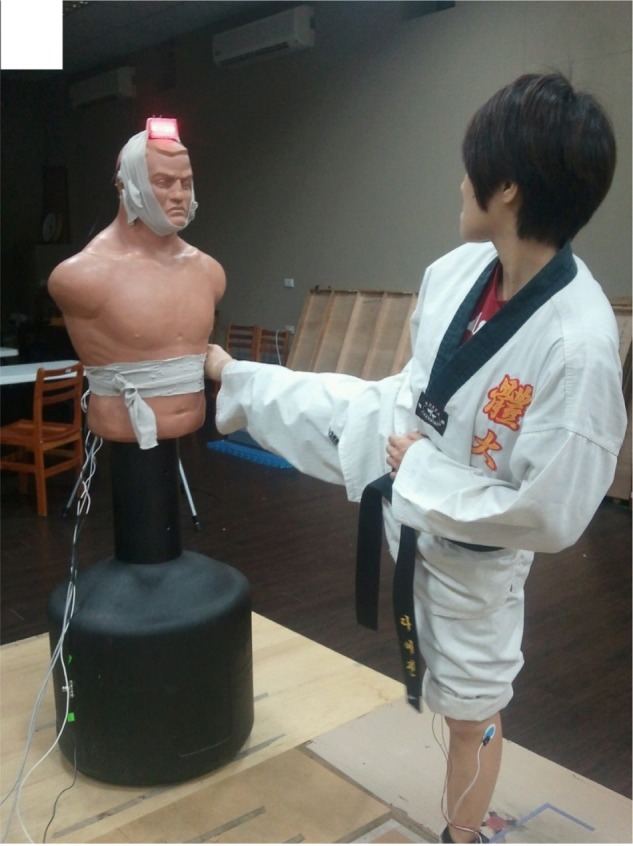
Movement A: a roundhouse kick to the rib.
Figure 4.
Movement B: (A) a roundhouse kick to the rib, (B) a roundhouse kick to the head, and (C) a reverse roundhouse kick to the head.
Figure 5.
Movement C: (A) a roundhouse kick to the rib, (B) a roundhouse kick to the head, (C) a reverse roundhouse kick to the head, (D) a roundhouse kick to the head, (E) a reverse roundhouse kick to the head, and (F) a roundhouse kick to the head.
Dual task
The dual-task movement D is composed of movement C and a secondary task. When the subjects were carrying out the movement C, research personnel turned on the light signal on the top of the dummy again. The subjects had to press the button on the left hand with the thumb as soon as they see the second light signal, while conducting movement C.
Each of the four movements was performed five times in a random order. A set of 20 random numbers was generated using Microsoft Excel 2010 to represent the 20 movements in one test session. The order of the 20 movements was written in a piece of paper. A total of 20 pieces were prepared and stored in an opaque box. Before the start of each test session, the subject drew a piece of instruction from the box and gave it to a researcher. The researcher then told the subject which movement has to be performed prior to each movement.
Determination of variables
The premotor time was determined as the time from the beginning of the light signal to the start of EMG signal of the left thenar muscles. The thenar muscles were used because they provide much clearer EMG signal compared to that of the leg muscles. The EMG signal from the leg muscles was noisy due to the unconscious preparation for the kicks before the light, even though the subjects were asked to stand still prior to each test. The movement time is between the right leg leaving the force platform and the appearance of signal in the accelerometer in the dummy.
The performance of the secondary task is defined as the time between the beginning of the second light signal and pushing the button. So the performance of the secondary task involves the premotor time and movement time. EMG signal is not used in measuring the secondary task because it is present throughout the duration of the first task. Therefore, it is very difficult to identify the EMG signal that triggers the movement to press the button.
Statistical analysis
Intraclass correlation coefficient (ICC) was calculated using the results of ten trials on days 1 and 2 to examine test–retest reliability. ICC above 0.75 is considered high, that in the range 0.50–0.75 is considered moderate, and that below 0.50 is considered low.9
The validity was examined by analyzing the difference between the elite and sub-elite subjects by t-test. The average value of ten trials on both the days was used for the comparison. The difference in the premotor time and movement time among the four movements in the same group was analyzed by one-way analysis of variance with repeated measurement (rANOVA). If the main effect was significant, the Tukey’s method was used to identify the difference. A P-value less than 0.05 was considered statistically significant.
Results
Test–retest reliability
The ICCs of premotor time, motor time, and reaction time in the secondary task in elite and sub-elite taekwondo athletes are shown in Table 2. In the premotor time, the results of ten trials in each movement showed moderate correlation as most ICCs were between 0.50 and 0.75. The elite group showed lower ICCs than the sub-elite group in all the four movements. In the motor time, most ICCs showed high correlation in both groups of athletes. The results of the secondary task were also moderately correlated.
Table 2.
ICCs of premotor time, motor time, and secondary task in days 1 and 2 in the elite and sub-elite athletesa (mean±SD)
| Elite
|
Sub-elite
|
||||||
|---|---|---|---|---|---|---|---|
| Day 1 (s) | Day 2 (s) | ICCb | Day 1 (s) | Day 2 (s) | ICCb | ||
| Premotor time | |||||||
| A | 0.141±0.012 | 0.145±0.015 | 0.634 | 0.165±0.031 | 0.148±0.016 | 0.694 | |
| B | 0.143±0.013 | 0.146±0.016 | 0.439 | 0.186±0.037 | 0.166±0.021 | 0.681 | |
| C | 0.146±0.018 | 0.147±0.015 | 0.634 | 0.189±0.035 | 0.168±0.034 | 0.725 | |
| D | 0.143±0.013 | 0.149±0.019 | 0.547 | 0.182±0.040 | 0.169±0.031 | 0.824 | |
| Motor time | |||||||
| A | 0.261±0.034 | 0.257±0.026 | 0.926 | 0.268±0.026 | 0.279±0.043 | 0.721 | |
| B | 0.291±0.026 | 0.271±0.032 | 0.861 | 0.293±0.036 | 0.287±0.031 | 0.907 | |
| C | 0.292±0.032 | 0.282±0.031 | 0.942 | 0.313±0.041 | 0.295±0.029 | 0.834 | |
| D | 0.294±0.037 | 0.282±0.038 | 0.956 | 0.303±0.032 | 0.299±0.034 | 0.931 | |
| Secondary task | |||||||
| D | 0.243±0.029 | 0.252±0.030 | 0.692 | 0.389±0.136 | 0.351±0.063 | 0.676 | |
Notes:
The data of each day represent the average of five trials on the same day;
calculated from the total of ten trials in 2 days.
Abbreviations: ICC, intraclass correlation coefficient; s, seconds; SD, standard deviation.
Discriminant validity
The elite athletes had significantly faster premotor time than their sub-elite counterparts in all the four movements (Table 3). However, the elite and sub-elite groups had similar motor time in all the four movements. The largest difference lies in the reaction time in the secondary task, in which the elite group was 33.0% faster than the sub-elite group. In the elite group, the premotor time was similar across the movements with different levels of complexity (Table 3). On the other hand, the premotor time was the fastest in the simplest movement A compared to the other movements in the sub-elite group. In the motor time, both the groups were significantly faster in movement A than the other more complicated movements.
Table 3.
The comparison of premotor time, motor time, and secondary task performance in different movements in the elite and sub-elite taekwondo athletesa (mean±SD)
| Elite(s) | Sub-elite(s) | P-value | |
|---|---|---|---|
| Premotor time | |||
| A | 0.143±0.012 | 0.156±0.020* | 0.072 |
| B | 0.144±0.010 | 0.176±0.027 | 0.002 |
| C | 0.147±0.014 | 0.176±0.033 | 0.005 |
| D | 0.146±0.011 | 0.176±0.033 | 0.011 |
| Motor time | |||
| A | 0.259±0.029† | 0.274±0.028¶ | 0.210 |
| B | 0.281±0.027 | 0.290±0.030 | 0.483 |
| C | 0.287±0.009 | 0.304±0.031 | 0.187 |
| D | 0.288±0.037 | 0.301±0.031 | 0.367 |
| Secondary task | |||
| 0.248±0.026 | 0.370±0.081 | <0.001 | |
Notes:
The data represent the average of ten trials on both the days;
significantly different from movement C in the sub-elite group;
significantly different from movements B, C, and D in the elite group;
significantly different from movements C and D in the sub-elite group.
Abbreviations: s, seconds; SD, standard deviation.
Discussion
The results of this study showed significant test–retest reliability as the ICCs of premotor, motor, and movement times in single- and dual-task methods in both the elite and sub-elite taekwondo athletes were substantial. In addition, both the methods could successfully distinguish elite and sub-elite athletes, with the dual-task method showing greater discriminant validity.
The premotor time in roundhouse kicks showed moderate-to-high levels of correlation in both single- and dual-task situations in both the groups of subjects. The reaction time in the secondary task also showed moderate-to-high levels of consistency. The performance in the secondary task in movement D also showed high levels of consistency in both the groups.
The average premotor time in movement A in elite athletes was 14.0% faster than that in the sub-elite athletes. The difference increased to 16.5%–18.2% in the more complicated movements B, C, and D. On the other hand, the motor time in all the movements was similar in both the groups. The results suggested that the difference in the premotor time may contribute to the success in taekwondo competitions. In addition, the elite and sub-elite subjects have similar ability in conducting the roundhouse kicks after many years of practice. The elite subjects were significantly taller than the sub-elite subjects in the present study. To our best knowledge, there is no study investigating the effect of height on the premotor time. Even if height is a factor in the premotor time, the taller subjects would be expected to be slower due to longer transduction of the neural signal. However, the present study showed that the taller elite subjects had faster premotor time than the shorter sub-elite subjects. These results indicated that the small difference (3.3%) in height may not be an important factor in determining the premotor time.
The performance in the secondary task appeared to be the variable with the highest discriminative validity in this study. The average time in the secondary task in elite athletes was 33.0% faster than that in the sub-elite athletes. It suggested that the elite athletes were more proficient, and thus required less attention, in conducting the complicated movement. It is reasonable to assume that, with more attention capacity that can be freed from the primary task, the elite athletes may be better in analyzing and predicting opponent’s response while conducting the movement. This ability would lead to more success in taekwondo competitions. Several studies on various sports have also shown that the experts performed better under dual-task situations than the novice, even though the performance may be indistinguishable in the single-task situation. The proficiency of 2-on-1 draw-and-pass drill under the dual-task situation was significantly higher in the professional rugby league players than in their semiprofessional counterparts. The secondary task required the subjects to identify as quickly and accurately as possible the frequency of a verbal tone. The proficiency of the same 2-on-1 drill performed under the single-task situation did not discriminate the professional and semiprofessional players.10 In addition, the proficiency of off-field draw-and-pass task under the dual-task situation was significantly correlated with the number of successful draw-and-pass in real competitions in professional rugby league players, while the proficiency of the same task under the single-task situation was not correlated with the success on the field.11 Beilock et al12 used the identification of a target word as the secondary task during the golf putting task. The results showed a positive correlation between the error in the secondary task and the inaccuracy in the primary putting task. It indicated that the less-skilled golfers allocated more attention to the putting task, resulting in the decreased performance in the secondary task.
One potential drawback for dual-task methodology is that the subjects may sacrifice the primary task performance to execute the secondary task.13 The dual-task cost, the difference in primary task performance between the single- and dual-task scenarios, has been shown to increase with the increased complexity of dual-task situations.14 However, the premotor time and movement time were similar between movements C and D in both the groups. Since the primary task in movement D is identical to movement C, these results indicated that our subjects maintained the performance in the primary task in the dual-task test. The dual-task cost in the present study is nonexistent.
The simple reaction time may not have high discriminative validity in taekwondo athletes. It has been suggested that elite taekwondo athletes showed significantly faster reaction time than their sub-elite counterparts in roundhouse kick. The difference was smaller in the dominant leg (elite 0.44±0.10 seconds vs sub-elite 0.51±0.15 seconds) than in the nondominant leg (elite 0.39±0.03 seconds vs sub-elite 0.49±0.02 seconds).15 The total reaction time in Germany national taekwondo male athletes was also significantly faster than that in the recreational taekwondo participants, although the differences were small, ranging from 20 milliseconds to 50 milliseconds in shoulder, hip, and ankle joints. However, the total reaction time in female athletes in the national team was not significantly different from that of recreational athletes.5 Furthermore, the reaction time for roundhouse kick to the chest or head was not significantly different between experts and novice taekwondo athletes.3 It is noteworthy that the reaction time in the aforementioned studies included the premotor time and motor time, making it longer than the premotor time in our results.
The elite athletes showed similar premotor time across the four movements with different levels of complexity. The sub-elite athletes also showed similar premotor time in the three more complicated movements, although the premotor time in the simplest movement A was faster than the other three movements. The lack of difference in the premotor time between movements B, C, and D is contradictory to the memory drum theory proposed by Henry and Rogers.16 The memory drum theory has been challenged recently, but the alternative model that can fully explain the situations has yet been established.17 This exact mechanism underlying this phenomenon requires further investigation.
In conclusion, this study establishes an easy-to-apply method to measure the attention demand and skill proficiency in taekwondo athletes. Our method is similar to that in real taekwondo competitions in which the athletes have to track and predict the opponent’s movements while performing the current attack or defensive task. In most situations, the instruments and/or the time of the athletes are limited. The performance in the secondary task can be measured without force platform and EMG while providing the highest validity. Only the light signal and the handheld button are required. The athletes with better performance in the secondary task may undergo training in more complicated situations in which he/she has to read and predict the opponent’s movements. On the other hand, the athletes with lower performance in the secondary task may require more practice in the main skills in the single-task situation or in less complicated dual-task environment.
Footnotes
Disclosure
The authors report no conflicts of interest in this work.
References
- 1.Pieter F, Pieter W. Speed and force in selected taekwondo techniques. Biol Sport. 1995;12(4):257–266. [Google Scholar]
- 2.Kim JW, Kwon MS, Yenuga SS, Kwon YH. The effects of target distance on pivot hip, trunk, pelvis, and kicking leg kinematics in Taekwondo roundhouse kicks. Sports Biomech. 2010;9(2):98–114. doi: 10.1080/14763141003799459. [DOI] [PubMed] [Google Scholar]
- 3.Estevan I, Falco C. Mechanical analysis of the roundhouse kick according to height and distance in taekwondo. Biol Sport. 2013;30(4):275–279. doi: 10.5604/20831862.1077553. [DOI] [PMC free article] [PubMed] [Google Scholar]
- 4.Schmidt RA, Lee TK. Motor Control and Learning: A Behavior Emphasis. 5th ed. Champaign, IL: Human Kinetics; 2011. [Google Scholar]
- 5.Vieten M, Scholz M, Kilani H, Kohloeffel M. XXV ISBS Symposium. Ouro Preto; Brazil: 2007. Reaction time in taekwondo. [Google Scholar]
- 6.Schmidt RA, Wrisberg CA. Motor Learning and Performance: A Situation-based Learning Approach. 4th ed. Champaign, IL: Human Kinetics; 2008. [Google Scholar]
- 7.Abernethy B. Dual-task methodology and motor skills research: some applications and methodological constraints. J Hum Mov Stud. 1988;14:101–132. [Google Scholar]
- 8.Huang HJ, Mercer VS. Dual-task methodology: applications in studies of cognitive and motor performance in adults and children. Pediatr Phys Ther. 2001;13(3):133–140. [PubMed] [Google Scholar]
- 9.Portney LG, Watkins MP. Foundations of Clinical Research: Applications to Practice. 3rd ed. Upper Saddle River, NJ, USA: Prentice Hall; 2008. [Google Scholar]
- 10.Gabbett TJ, Jenkins DG, Abernethy B. Relative importance of physiological, anthropometric, and skill qualities to team selection in professional rugby league. J Sports Sci. 2011;29(13):1453–1461. doi: 10.1080/02640414.2011.603348. [DOI] [PubMed] [Google Scholar]
- 11.Gabbett TJ, Abernethy B. Dual-task assessment of a sporting skill: influence of task complexity and relationship with competitive performances. J Sports Sci. 2012;30(16):1735–1745. doi: 10.1080/02640414.2012.713979. [DOI] [PubMed] [Google Scholar]
- 12.Beilock SL, Carr TH, MacMahon C, Starkes JL. When paying attention becomes counterproductive: impact of divided versus skill-focused attention on novice and experienced performance of sensorimotor skills. J Exp Psychol. 2002;8(1):6–16. doi: 10.1037//1076-898x.8.1.6. [DOI] [PubMed] [Google Scholar]
- 13.Guttentag RE. Age differences in dual-task performance: procedures, assumptions, and results. Dev Rev. 1989;9:146–170. [Google Scholar]
- 14.McDowd JM, Craik FI. Effects of aging and task difficulty on divided attention performance. J Exp Psychol Hum Percept Perform. 1988;14:267–280. doi: 10.1037/0096-1523.14.2.267. [DOI] [PubMed] [Google Scholar]
- 15.Chu MY. Case Study on Comparison and Exploration of Dominant and Non-Dominant Leg and Continuously Jump Double Roundhouse Kick in Elite and Sub-Elite Taekwondo Athletes. Taoyuan, Taiwan: Graduate Institute of Coaching Science, National Taiwan Sport University; 2010. [Google Scholar]
- 16.Henry FM, Rogers DE. Increased response latency for complicated movements and a memory drum theory of neuromotor reaction. Res Q. 1960;31:448–458. [Google Scholar]
- 17.Klapp ST. Comments on the classic Henry and Rogers (1960) paper on its 50th anniversary: resolving the issue of simple versus choice reaction time. Res Q Exerc Sport. 2010;81(1):108–112. doi: 10.1080/02701367.2010.10599654. [DOI] [PubMed] [Google Scholar]



